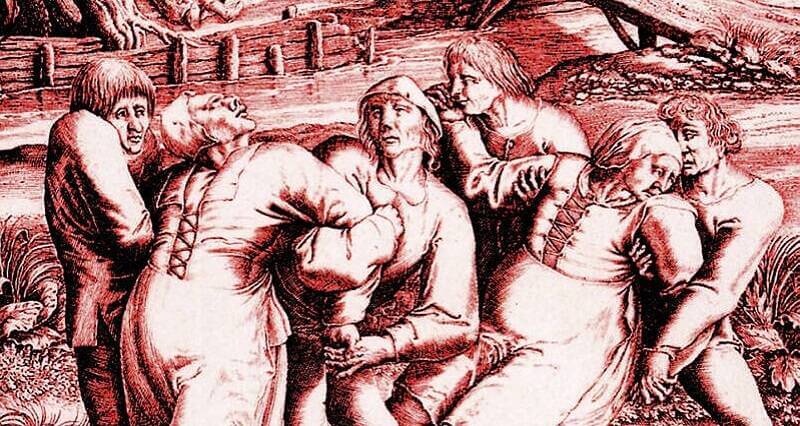The Stress of Modern Life: Our 2024 Version of the Dancing Plague?
The stress we face today may not lead to physical collapse like it did in 1518, but it's still pervasive, affecting our health and well-being in ways that feel relentless. Just as people 'danced themselves to death' centuries ago, are we pushing ourselves to our limits in different ways today?

Dancing is great cardio but in 1518, it led to many deaths…
The stress we face today may not lead to physical collapse like it did in 1518, but it's still pervasive, affecting our health and well-being in ways that feel relentless. Just as people 'danced themselves to death' centuries ago, are we pushing ourselves to our limits in different ways today?
What is the Dancing Plague of 1518?
The plague took place in a region called Strasbourg, Alsace (modern-day France), in the Holy Empire from July 1518 to September 1518.
It all began with a woman Frau Troffea who suddenly began to dance uncontrollably in a street in Strasbourg. No music, just her and her moves. Eventually, others who watched began to mimic her and danced themselves.
The city even constructed a stage and professional dancers were brought in. The town even hired a band to provide backing music, but it wasn’t long before the marathon started to take its toll.
After a week, 38 others joined the dancing concert. A few months later, by August the 'dancing plague' claimed 400 victims.
Dancers began to collapse, some died from heart attacks or strokes. Some wouldn't stop dancing only death would make them stop…
Many dancers were told to head to the shrine of Saint Vitus, they wore red shoes sprinkled with holy water and crosses on top of the soles. After a short ritual, asking Vitus for forgiveness by September the dancing began to subside.
The word spread and the dancing plague ended.
Other similar occurrences
Events similar to this are said to have occurred throughout the medieval age including the 11th century in Kölbigk, Saxony, where it was believed to be the result of divine judgment.
In 15th century Apulia, Italy,[8] a woman was bitten by a tarantula, the venom making her dance convulsively. The only way to cure the bite was to "shimmy" and to have the right sort of music available, which was an accepted remedy by scholars like Athanasius Kircher.
8. Soth, Amelia (2019-01-10). "When Dancing Plagues Struck Medieval Europe". JSTOR Daily. Retrieved 2023-04-25.
Theories
While the specifics of the 1518 plague seem like a bizarre anomaly from the past, its root causes—stress, anxiety, and the overwhelming pressures of life—are still all too familiar today.
But instead of dancing uncontrollably, we might find ourselves trapped in cycles of overwork, digital addiction, or other harmful behaviours.
Induced mass hysteria
Some suggest that the dancing was a result of a mass psychogenic movement disorder, where stress and psychological factors led large groups of people to exhibit the same uncontrollable behaviour.
This type of disorder is caused by stresses that include starvation and disease.
The psychogenic illness could have created chorea (from the Greek khoreia meaning "to dance"), a situation comprising random and intricate unintentional movements that flit from body part to body part.
Ergot / Food poisoning

Dancing is great cardio but in 1518, it led to many deaths…
The stress we face today may not lead to physical collapse like it did in 1518, but it's still pervasive, affecting our health and well-being in ways that feel relentless. Just as people 'danced themselves to death' centuries ago, are we pushing ourselves to our limits in different ways today?
What is the Dancing Plague of 1518?
The plague took place in a region called Strasbourg, Alsace (modern-day France), in the Holy Empire from July 1518 to September 1518.
It all began with a woman Frau Troffea who suddenly began to dance uncontrollably in a street in Strasbourg. No music, just her and her moves. Eventually, others who watched began to mimic her and danced themselves.
The city even constructed a stage and professional dancers were brought in. The town even hired a band to provide backing music, but it wasn’t long before the marathon started to take its toll.
After a week, 38 others joined the dancing concert. A few months later, by August the 'dancing plague' claimed 400 victims.
Dancers began to collapse, some died from heart attacks or strokes. Some wouldn't stop dancing only death would make them stop…
Many dancers were told to head to the shrine of Saint Vitus, they wore red shoes sprinkled with holy water and crosses on top of the soles. After a short ritual, asking Vitus for forgiveness by September the dancing began to subside.
The word spread and the dancing plague ended.
Other similar occurrences
Events similar to this are said to have occurred throughout the medieval age including the 11th century in Kölbigk, Saxony, where it was believed to be the result of divine judgment.
In 15th century Apulia, Italy,[8] a woman was bitten by a tarantula, the venom making her dance convulsively. The only way to cure the bite was to "shimmy" and to have the right sort of music available, which was an accepted remedy by scholars like Athanasius Kircher.
8. Soth, Amelia (2019-01-10). "When Dancing Plagues Struck Medieval Europe". JSTOR Daily. Retrieved 2023-04-25.
Theories
While the specifics of the 1518 plague seem like a bizarre anomaly from the past, its root causes—stress, anxiety, and the overwhelming pressures of life—are still all too familiar today.
But instead of dancing uncontrollably, we might find ourselves trapped in cycles of overwork, digital addiction, or other harmful behaviours.
Induced mass hysteria
Some suggest that the dancing was a result of a mass psychogenic movement disorder, where stress and psychological factors led large groups of people to exhibit the same uncontrollable behaviour.
This type of disorder is caused by stresses that include starvation and disease.
The psychogenic illness could have created chorea (from the Greek khoreia meaning "to dance"), a situation comprising random and intricate unintentional movements that flit from body part to body part.
Ergot / Food poisoning
While some have suggested that ergot poisoning—caused by a fungus in rye—might be responsible, historian John Waller points out that this is unlikely.
He argues that the affected people wouldn’t have danced for days on end, and that ergot poisoning would have caused different symptoms in different individuals, not a uniform outbreak of dancing. This compound mimics LSD-25.
John Waller has written several journal articles on the subject and the book A Time to Dance, a Time to Die: The Extraordinary Story of the Dancing Plague of 1518.
Religious explanations
Explanations included demonic possession and overheated blood.[5]
5. Bauer, Patricia. "Dancing plague of 1518 | Facts & Theories | Britannica". www.britannica.com. Retrieved 2023-04-24.
What would be like the dancing plague of today?
Just as the residents of Strasbourg struggled to cope with their stress in ways that led to their undoing, we too face modern forms of overwhelming pressure. But while their 'cure' involved rituals and holy water, today we have more effective strategies for managing our stress—if we’re willing to embrace them.
Reducing Stress
In an age where social media addiction often replaces genuine connection, practices like mindfulness and face-to-face human interaction can help break the cycle.
Stress lives amongst everyone, let's take a look a various stress-relieving areas and techniques we can implement to help us take control of stress!
Cardio / Strength Training
Moving the body in any shape or form is a stress reliever. This happens as our bodies begin to pump the feel good endorphins out along with other chemicals. When the chemicals begin to flow it elevates our mood, and helps to refocus our minds.
Why do you see people who end a relationship in the gym using that as motivation to work out? Well, makes them feel good!
As someone who has worked out for twenty years now, the feeling during and after is euphoric. It makes me feel great but also help to clear my mind of clutter or lingering thoughts. I suggest implementing this workouts into your routine with a blend of both cardio and weight training exercises.
Healthy diet
I don't think this is new information but, what you consume, will dictate how you feel tomorrow. If you had a night out drinking excessively and eating junk at 3am, then of course it's likely you'll feel horrid the next day.
Versus, eating a decent diet (not only chicken and broccoli, you know that gym bro diet) but mostly nutritious foods, with minimally processes ingredients will do wonders.
Sleep
Stress is a protagonist to sleep meaning the more stress we have the poorer sleep will have. This is a compounding effect, that begins to snowball over time. Most adults need probably around 7 to 9 hours of sleep a night.
A few tips that can help with your sleep:
- Get of the screen at least two hours before bed
- No caffeine after noon
- Try to limit your liquid intake one hour before bed
- Replace television or devices with reading
- If you do get up in the night and can;'t settle, try going into another room for a bit, 10 - 15 minutes head back to bed and try again
Meditation
When you meditate, you're directing your attention and calming the flow of scattered thoughts that might be stressing you out. This practice can bring a sense of peace and balance, benefiting both your mental health and overall wellness.
There are many ways to meditate, such as guided meditation, mindfulness, visualization, and more, and you can do them anytime, anywhere.
For instance, you could meditate while walking, commuting, or sitting in a waiting room.
Apps can guide you through these techniques, and deep breathing exercises are something you can do wherever you are.
Human Connecting
When you're feeling stressed or irritated, it's tempting to withdraw, but reaching out to family and friends can help. Even having just one close friend to talk to can make a big difference.
Connecting with others can relieve stress by offering a distraction, support, and a reminder that you're not alone in dealing stress challenges.
Maybe grab a coffee with a friend, sending a message to a family member, or visiting your local community space.
If you have extra time, volunteering for a charity can be a great way to support yourself while also helping others.
Final Thoughts
The people of Strasbourg may have succumbed to their stress in catastrophic ways, but today we have better tools at our disposal if we're willing to embrace them.
Though the challenges we face today may be different in form, they can still feel just as overwhelming. The key difference is that we now have the knowledge and tools to break the cycle. The question is—will we use them?



